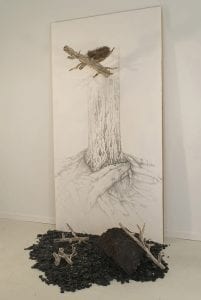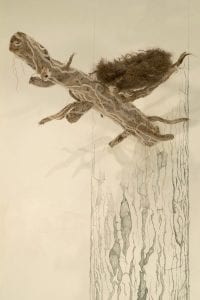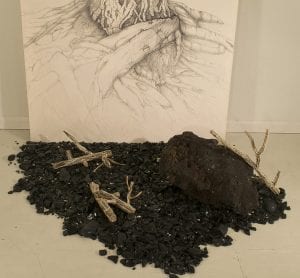March 21, 2019
My first blog must include a big thank you to Creative Pinellas! I’m delighted and pleased to be awarded a 2019 Professional Artist Grant.
Now on to what is happening in the studio. As usual I am working on multiple bodies of work at once. It seems to be my style. This week I want to talk about the series of work that is front and center. The statement for this body of work with a few photos of the first completed in the series follows.
“Hair Nests”
“Hair Nests” is a series of ten works begun in 2014, but set aside while I concentrated on different projects. I’m happy to announce, it is again the focus of my efforts.
Each work contains a tree branch, either artificial or real. Each branch projects out from a large seven-foot graphite drawing of a tree. In some case, pieces of the branch litter the ground below among stones and boulders. The branches are constructed in a variety of materials. They include glass, actual branch, paper, or silk organza. A nest — fabricated from my hair — rests in a fork of a branch or on the floor. Each nest is constructed with a year of my hair loss. A thyroid condition in 1998 caused an increase in the loss of my hair and I began collecting the hair on a daily basis. In turn, the loss turned my thoughts to aging and the erosion of one of the significant measures of beauty — hair.
Trees entered the equation for numerous reasons. Obviously, they are an essential part of our existence. They are awe-inspiring beautiful and critically environmental. Scientists record twenty-two benefits, encompassing climate change, air quality, erosion, and food as well as less measurable elements as season change, shade, wildlife protection, economic, reducing violence, adding unity and so-forth. In my public housing stay as a teenager, I cannot remember one mature tree on the grounds.
At this stage of the environmental challenge, tree markers are vital — the trunk scars and burns and tree-ring dating provides a climate history for each yearly ring. They speak of life, of an existence not distant from our own, affected by elements beyond their and our control — drought, fire, disease and of course, humans. One does notice a pattern here.
Yet, they endure. They live on. Some giant California sequoias are nearly 400 years old. These redwoods are handily surpassed in age by numerous Southern cypress and Northern white cedar. And finally, three Ginkgo trees in Hiroshima survived the atomic blast that devastated miles and miles of landscape. In days after the explosion, it was reported the trees had budding leaves.
This perseverance is consequential to the work, carrying it beyond my concept to a mortality admired and deserved.
It is hardly a reach for me to blend tree drawings and limb sculptures with the signature component of all my work — human hair. Hair contains our complete DNA and lives beyond death. Its appearance varies among cultures. Several religions dictate women cover their hair. Other cultures beautify it. (Consider the thousands of hair products and procedures for women and men alike.) Hair is hoarded as a keepsake, often in a locket or pressed into a Bible. Conversely, consider the yang — the repulsion of a hair tendril on a dinner plate or a wad plugging the shower drain.
Closer to home, I’ve been complimented on my hair all my life, setting a synergy in place between it and beauty. Once hair loss began, self-doubt was close behind. The hoarding of this loss on a daily basis became a chronicle. A personal calligraphy evolved as I fashioned each day’s loss into a doodle,. This granted my loss an entirely different existence. What was once troubling was now a message on the contextual relationship of beauty. My hair was enduring, aesthetic, and flexible.
Thinking of hair in this context led me to consider it in the context of poverty and the environment. The question in my mind boiled down to “What represents security in an environmental milieu?” Over a period of several years, I photographed and drew trees. First, their textural and aesthetic appealed to me. Over time, it became personal as I chose favorite trees, liking this one and that one. I looked forward to seeing these favorites as I walked my dogs, discovering something new about each. One day, I still recall the day I noticed a nest nestled among the limbs and thus, began the genesis of inspiration.

Size: 60 w x 90 h x 52 d inches
Medium: Graphite on paper and modeling paste on panel, nest made of my hair Loss from 2016, branches made of rust/tea stained silk organza, hardware wire thread yarns and wire mesh, black glass, black fire glass, Mexican beach stones, and Lava boulder.

Size: 60 w x 90 h x 52 d inches
Medium: Graphite on paper and modeling paste on panel, nest made of my hair Loss from 2016, branches made of rust/tea stained silk organza, hardware wire thread yarns and wire mesh, black glass, black fire glass, Mexican beach stones, and Lava boulder.

Size: 60 w x 90 h x 52 d inches
Medium: Graphite on paper and modeling paste on panel, nest made of my hair Loss from 2016, branches made of rust/tea stained silk organza, hardware wire thread yarns and wire mesh, black glass, black fire glass, Mexican beach stones, and Lava boulder.


